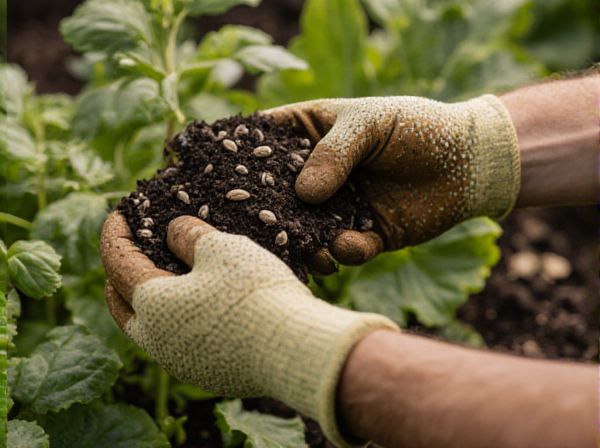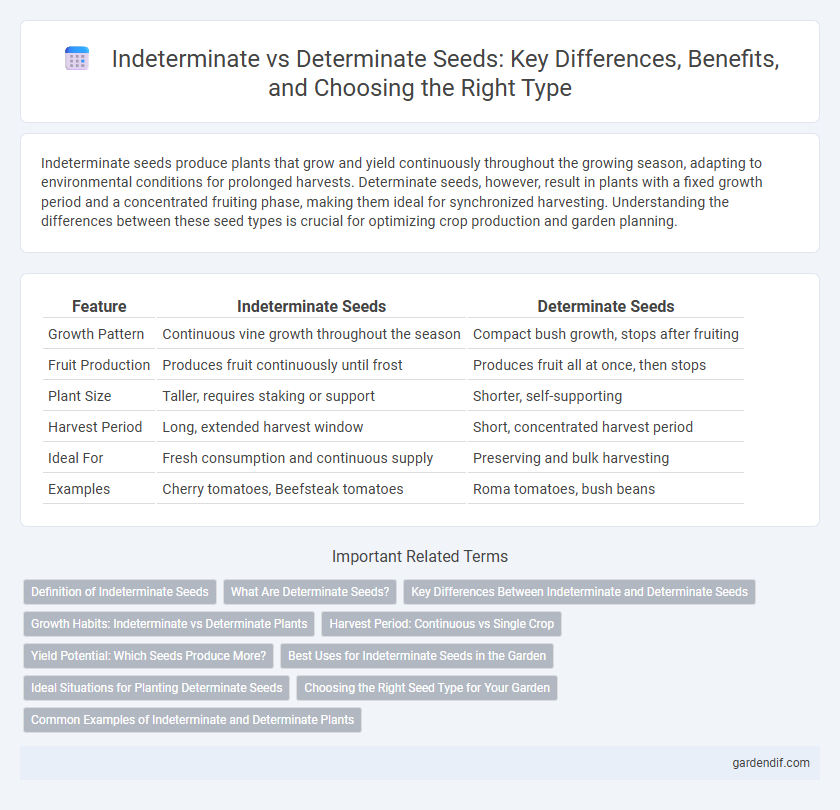
Indeterminate Seeds vs Determinate Seeds Illustration
Indeterminate seeds produce plants that grow and yield continuously throughout the growing season, adapting to environmental conditions for prolonged harvests. Determinate seeds, however, result in plants with a fixed growth period and a concentrated fruiting phase, making them ideal for synchronized harvesting. Understanding the differences between these seed types is crucial for optimizing crop production and garden planning.
Table of Comparison
| Feature | Indeterminate Seeds | Determinate Seeds |
|---|---|---|
| Growth Pattern | Continuous vine growth throughout the season | Compact bush growth, stops after fruiting |
| Fruit Production | Produces fruit continuously until frost | Produces fruit all at once, then stops |
| Plant Size | Taller, requires staking or support | Shorter, self-supporting |
| Harvest Period | Long, extended harvest window | Short, concentrated harvest period |
| Ideal For | Fresh consumption and continuous supply | Preserving and bulk harvesting |
| Examples | Cherry tomatoes, Beefsteak tomatoes | Roma tomatoes, bush beans |
Definition of Indeterminate Seeds
Indeterminate seeds refer to those produced by plants that continue to grow and produce fruit throughout the growing season without a fixed harvest time, allowing for ongoing seed development. These plants do not have a predetermined size or flowering period, enabling continuous seed formation as long as environmental conditions remain favorable. Indeterminate seed production is common in crops like tomatoes and cucumbers, where prolonged growth supports extended seed maturation.
What Are Determinate Seeds?
Determinate seeds produce plants that grow to a fixed size and stop growing once they reach maturity, making them ideal for gardeners seeking a controlled plant size and predictable harvest. These seeds typically yield fruit all at once, allowing for easier and quicker harvesting compared to indeterminate plants. Popular determinate varieties include certain tomato and pepper seeds, prized for their compact growth habit and suitability for container gardening or limited space.
Key Differences Between Indeterminate and Determinate Seeds
Indeterminate seeds produce plants that grow and flower continuously throughout the growing season, offering an extended harvest period. Determinate seeds result in plants that grow to a fixed mature size, flowering and fruiting all at once, making them ideal for a single harvest. Key differences include growth habit, yield timing, and space requirements, with indeterminate varieties requiring more staking and space and determinate types demanding less maintenance.
Growth Habits: Indeterminate vs Determinate Plants
Indeterminate seeds produce plants with a continuous growth habit, allowing stems and fruits to develop throughout the growing season until frost stops growth. Determinate seeds yield plants that grow to a fixed size, setting fruit simultaneously and halting further vertical growth once mature. Understanding these growth habits influences planting strategies and harvesting methods for crops like tomatoes and beans.
Harvest Period: Continuous vs Single Crop
Indeterminate seeds produce plants that flower and yield fruit continuously throughout the growing season, enabling a prolonged harvest period ideal for successive picking. In contrast, determinate seeds yield plants that mature all at once, resulting in a single, concentrated harvest typically suited for bulk processing or preserving. This key difference affects garden planning, as indeterminate plants require ongoing maintenance to support extended production, while determinate plants demand synchronized care for a unified crop yield.
Yield Potential: Which Seeds Produce More?
Indeterminate seeds typically produce higher yield potential due to their extended fruiting period, allowing continuous harvests over several weeks or months. In contrast, determinate seeds generate a concentrated crop within a shorter timeframe, limiting overall yield but enabling simultaneous harvesting. Choosing between indeterminate and determinate seeds depends on desired harvest frequency and total crop output expectations.
Best Uses for Indeterminate Seeds in the Garden
Indeterminate seeds are ideal for gardeners seeking continuous harvests throughout the growing season, especially for crops like tomatoes, cucumbers, and beans that benefit from extended fruiting periods. These seeds produce plants that grow and produce fruit until frost, making them perfect for home gardens with limited space but high yield needs. Utilizing indeterminate seeds maximizes productivity and allows staggered harvesting, ensuring fresh produce over time rather than a single peak harvest.
Ideal Situations for Planting Determinate Seeds
Determinate seeds are ideal for planting in small gardens or containers where space is limited and a uniform harvest is preferred. These seeds produce plants that stop growing after reaching a certain size, making them suitable for environments with shorter growing seasons or limited sunlight. Determinate varieties require less staking and pruning, simplifying care and ensuring a predictable yield in controlled settings.
Choosing the Right Seed Type for Your Garden
Indeterminate seeds grow plants that continue producing fruit throughout the season, ideal for gardeners seeking continuous harvests and extended growing periods. Determinate seeds yield plants that produce a concentrated crop all at once, making them suitable for canning or preserving large quantities simultaneously. Selecting the right seed type depends on your garden space, desired harvest schedule, and personal preferences for crop management.
Common Examples of Indeterminate and Determinate Plants
Tomato plants serve as common examples of indeterminate and determinate seeds, with indeterminate varieties like the Brandywine and Cherokee Purple producing fruit continuously throughout the growing season. Determinate plants such as Roma and Celebrity tomatoes grow to a fixed size and yield all their fruit at once, making them ideal for container gardening and harvesting in bulk. Other examples of indeterminate seeds include cucumbers and pole beans, while bush beans and certain pepper varieties represent determinate types, each exhibiting distinct growth patterns and harvesting timelines.
Indeterminate Seeds vs Determinate Seeds Infographic

 gardendif.com
gardendif.com